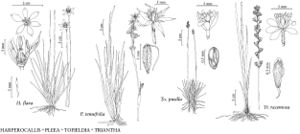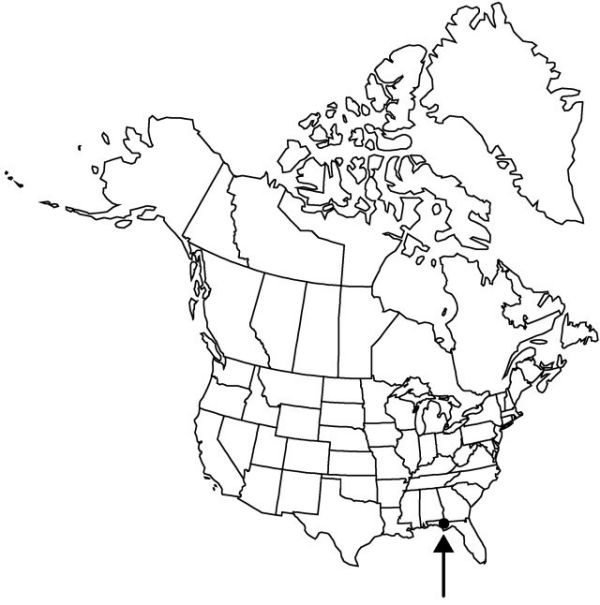Difference between revisions of "Harperocallis flava"
J. Arnold Arbor. 49: 38, figs. 1, 2. 1968.
FNA>Volume Importer |
imported>Volume Importer |
||
| (6 intermediate revisions by 2 users not shown) | |||
| Line 6: | Line 6: | ||
|place=49: 38, figs. 1, 2. 1968 | |place=49: 38, figs. 1, 2. 1968 | ||
|year=1968 | |year=1968 | ||
| + | }} | ||
| + | |special_status={{Treatment/ID/Special_status | ||
| + | |code=F | ||
| + | |label=Illustrated | ||
| + | }}{{Treatment/ID/Special_status | ||
| + | |code=E | ||
| + | |label=Endemic | ||
| + | }}{{Treatment/ID/Special_status | ||
| + | |code=C | ||
| + | |label=Conservation concern | ||
}} | }} | ||
|basionyms= | |basionyms= | ||
| Line 24: | Line 34: | ||
|distribution=Fla. | |distribution=Fla. | ||
|discussion=<p>Of conservation concern.</p><!-- | |discussion=<p>Of conservation concern.</p><!-- | ||
| − | --><p>Highly localized, Harperocallis flava occurs on gentle slopes, seepage savannas between pinelands, and cypress swamps to precariously open roadside depressions (R. K. Godfrey [1979]; R. Kral 1983; S. W. Leonard and W. W. Baker 1983; D. A. Wood 1996). It has distinctive showy, yellow, solitary flowers, and tuberculate ovaries and fruits. Genetic uniformity among individuals and populations of this species, in which 22 loci were found to be monomorphic, suggests low variability and serious conservation concern (M. J. W. Godt et al. 1997).</p> | + | --><p>Highly localized, <i>Harperocallis flava</i> occurs on gentle slopes, seepage savannas between pinelands, and cypress swamps to precariously open roadside depressions (R. K. Godfrey [1979]; R. Kral 1983; S. W. Leonard and W. W. Baker 1983; D. A. Wood 1996). It has distinctive showy, yellow, solitary flowers, and tuberculate ovaries and fruits. Genetic uniformity among individuals and populations of this species, in which 22 loci were found to be monomorphic, suggests low variability and serious conservation concern (M. J. W. Godt et al. 1997).</p> |
|tables= | |tables= | ||
|references= | |references= | ||
| Line 33: | Line 43: | ||
-->{{#Taxon: | -->{{#Taxon: | ||
name=Harperocallis flava | name=Harperocallis flava | ||
| − | |||
|authority=McDaniel | |authority=McDaniel | ||
|rank=species | |rank=species | ||
| Line 47: | Line 56: | ||
|publication title=J. Arnold Arbor. | |publication title=J. Arnold Arbor. | ||
|publication year=1968 | |publication year=1968 | ||
| − | |special status= | + | |special status=Illustrated;Endemic;Conservation concern |
| − | |source xml=https:// | + | |source xml=https://bitbucket.org/aafc-mbb/fna-data-curation/src/2e0870ddd59836b60bcf96646a41e87ea5a5943a/coarse_grained_fna_xml/V26/V26_23.xml |
|genus=Harperocallis | |genus=Harperocallis | ||
|species=Harperocallis flava | |species=Harperocallis flava | ||
Latest revision as of 22:13, 5 November 2020
Plants 22–55 cm, glabrous. Leaf blades linear, 0.2–0.3 × 5–21.5 cm, margins entire. Flowers: tepals yellow adaxially and greenish abaxially, becoming green to coppery, golden brown abaxially and purple-margined adaxially after anthesis,10–12-veined; outer tepal (10–)12–15 × (2.5–)3–3.5 mm; inner tepal (8–)9–12 × (2–)2.5–3.5 mm; stamens 8–9 mm; anthers 2.5–3.5 mm; styles 0.5–1 mm. Capsules 8–10 mm. Seeds 2–3 mm.
Phenology: Flowering late spring.
Habitat: Open ti-ti and pineland swamps to wet roadside ditches
Elevation: 0–10 m
Discussion
Of conservation concern.
Highly localized, Harperocallis flava occurs on gentle slopes, seepage savannas between pinelands, and cypress swamps to precariously open roadside depressions (R. K. Godfrey [1979]; R. Kral 1983; S. W. Leonard and W. W. Baker 1983; D. A. Wood 1996). It has distinctive showy, yellow, solitary flowers, and tuberculate ovaries and fruits. Genetic uniformity among individuals and populations of this species, in which 22 loci were found to be monomorphic, suggests low variability and serious conservation concern (M. J. W. Godt et al. 1997).
Selected References
None.

